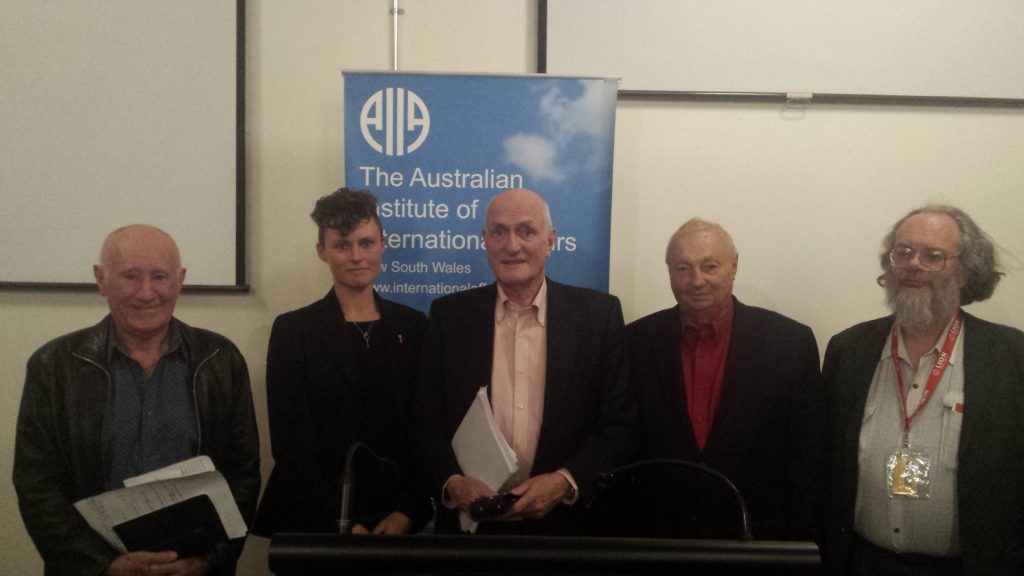The Serious Threat of Nuclear War
On Tuesday 24 October at Glover Cottages, AIIA NSW hosted a panel discussion on ‘The Serious Threat of Nuclear War’. The panellists were former AIIA NSW president Colin Chapman, councillor Robert Howard, and John Hallam from People for Nuclear Disarmament and Coordinator of the Human Survival Project. A special guest was Gemma Romuld, a founding member of the International Campaign against Nuclear Weapons (ICAN), which has just won the 2017 Nobel Peace Prize. The discussion was moderated by current NSW president, Richard Broinowski.
Colin Chapman opened by describing the history of nuclear weapons. He reminded the audience of the horrors of Hiroshima and Nagasaki, and of Stanislav Petrov, the Russian man who in 1983 courageously averted a nuclear strike between the Soviet Union and the United States which could have led to uncontrolled nuclear war. He lamented the brutal toll which British nuclear testing at Emu Field and Maralinga had exacted on Australia’s First People between 1956 and 1963. He reminded the audience that the Stockholm International Peace Research Institute (SIPRI) calculated that the United States and Russia have 6800 and 7000 nuclear weapons each, but that smaller players also had lethal, world-ending stockpiles: UK 200, France 300, China 270, India 130, Pakistan 120, Israel 80 and North Korea 10 to 20.
Robert Howard examined and rebutted the proposition that nuclear weapons prevent aggression and ensure the peace. Though the 72 years since World War II has been the longest period of great-power peace in human history, nuclear weapons ought not be thanked. Rather, they pose a catastrophic threat should their effect as a deterrent wear thin; and they had not deterred non-nuclear weapon states from engaging nuclear-armed states. The North Koreans and Vietnamese had not been deterred in waging war against the United States. Nor had Afghans, Iraqis or Syrians. And the policy of deterrence relies on a great degree of rationality, which Trump, Kim Jong-un and other leaders have undermined.
John Hallam asked: what are North Korea’s real capabilities? The country has short, intermediate and long range missiles. It has sea-launched missiles. It probably has miniaturised nuclear weapons, certainly fission bombs, possibly fusion ones too. It is in the process of developing heat shields to protect the nuclear weapons on the top of its missiles as they re-enter the atmosphere. It has a close technical relationship with Pakistan, collaboration which has no doubt enhanced its research and development capabilities. Tokyo, Seoul, Guam and Okinawa would not be beyond the range of its missiles. However, asserted John, Kim Jong-Un is not a madman and would only attack if convinced that North Korea was itself about to be attacked. Australia could play a role as honest broker, especially since receiving a letter of appeal from Pyongyang. Sadly however, this seemed unlikely to happen, especially since Mr Turnbull had made his unfortunate remark about being ‘joined at the hip’ with the United States.
The last speaker was Gemma Romuld. She advocated shifting the debate away from ‘national security’ and towards understanding the ill-effects of nuclear weapons on people, cities and the environment. In that spirit, ICAN had been instrumental in helping to usher in a comprehensive Treaty for the Prohibition of Nuclear Weapons, which 53 states have signed so far. None of the nuclear weapons states had done so, or those under their nuclear umbrellas like Australia, Japan and South Korea. But just as actions taken against the tobacco industry has reduced the popular will to smoke, so international opinion was shifting away from tolerance of nuclear weapons. Moral suasion might yet have surprising effects on the will and capacity of the weapons states to maintain their arsenals.

Robert Howard, Gemma Romuld, Richard Broinowski, Colin Chapman and John Hallam
Report by Rhys Carvosso
AIIA NSW Intern